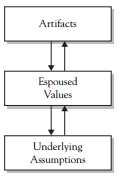Schein's model of organizational culture
Contents |
Abstract
The Schein's Model of Organizational Culture is a method which aims at explaining the concept of culture and the way it affects organizations.
It was introduced by Edgar Schein in 1980 in his endeavor to explain why people behave differently in various organizations.
The idea behind the method
Each company has its own culture as a unique identity. Edgar Schein realised that the culture of an organization affects how the people involved in it feel in the organization and how they perform for the organization.
Based on this observation, Schein introduced the Organizational Culture Model. Organizational culture is defined as a pattern of bassic assumptions that that a group has invented, discovered or developed in learning to cope with its problems of external adaptation and internal integration, and that have worked well enough to be considered valid, and therefore, to be taught to new members as the correct way to perceive, think, and feel in relation to those problems.
One of the concerns Schein had when defining the model was to make understand that culture is more complex than it seems. He thought that it is tempting to say that culture is just the way a company does the things, the company climate and the reward system. He pointed out that all of those are manifestations of the culture, but none is the culture at the level where culture matters.
Culture can be analysed at several different levels, with the term level meaning the degree to which the cultural phenomenon is visible to the observer. These levels range from the very tangible open manifestations that one can see and feel to the deeply embedded, unconscious, basic assumptions defined as te essence of culture. In between these layers are various espoused beliefs, values, norms and rules of behavious that members of the culture use as a way of depicting the culture to themselves and others.
Three levels in organizational culture
Behaviours and artifacts is the most manifest level of culture, consisting of the constructured physical and social environment of an organization. These mark the surface of the culture and they are the visible elements in the organization. Physical artifacts are presented in the architecture and interior arrangements, physical space and office design. Besides, language gives away culture through modes of speaking, slogans and expressions. Technology is also a part of the culture, since it reflects the values through operations, materials and knowledge. As it also is social practices, leadership practices and work tradtitions. They can be recognized by people not part of the culture but can be difficult to understand easily by everyone since they can be confusing.
Espoused values is a less visible level than behaviours and artifacts. The constituents of this level of culture provide the underlying meanings and interrelations by which the patterns of behaviours and artifacts may be deciphered. Espoused values are the organization's stated values and rules of behaviours. It is how the members represent the organization both to themselves and to others. This is often expressed in official philosophies and public statements of identity. It can sometimes often be a projectios for the future, of what the members hope to become.
Basic underlying assumptions represent and unconscious level of culture, at which the underlying values have, over a period of time, been transformed and are taken for granted as an organizationally acceptable way of perceiving the world. By this definition, basic assumptions are also the most difficult to relearn and change. Besides, the underlying assumptions are often difficult to describe and are only really understood by people who have become accustomed to the way the organization works. Those are usually invisible. They are not written down anywhere and people may not want to talk about them, but they exist and are often powerful.
When basic assumptions are understood, the apparently isolated and confusing artifacts and values become coherent. There are six types of assumptions that form the paradigm for every organization:
1. Assumptions about what is the truth in physical and social matters.
2. Assumptions about the importance of time in a group
3. Assumptions about how space is to be owned and allocated, the symbolic meaning of space around people.
4. Basic asumptions about the intrinsic or ultimate aspects of human nature, whether the human nature is fundamentally good of bad.
5. Assumptions about the organization's relationship with its environment and about the understanding of work.
6. Assumptions about the right way for people to relate with each other, the appropiate ways to distribute power and responsibilities and the appropiate ways of resolving conflicts and making decisions.
